Postpublished at 09:51 GMT 20 March 2015
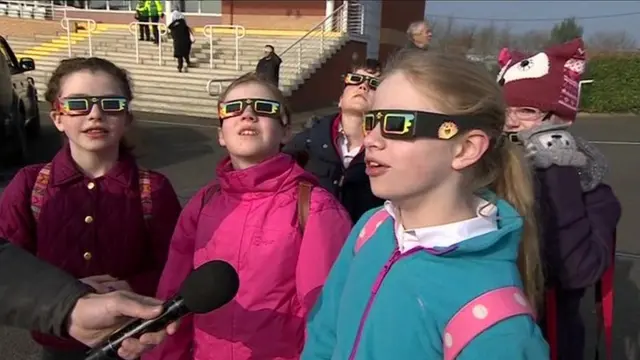
These schoolchildren from Leicester are intrigued by the eclipse.
"The sun changes colour and goes into a crescent shape," one commented.
All parts of the UK have been witnessing a partial solar eclipse, which started at about 08:18 GMT in southern England and peaked at around 09:36
The Faroe Islands and Svalbard in the Arctic Circle were the only places to experience a total eclipse
The amount of the sun's disc which is obscured varied from 96% in northern Scotland to 83% in southern England
Chris Lansdown, Lauren Turner, Kerry Alexandra, Jennifer Green and Michael Orwell

These schoolchildren from Leicester are intrigued by the eclipse.
"The sun changes colour and goes into a crescent shape," one commented.
In parts of India, people fast during a solar eclipse due to the belief that food cooked during an eclipse will be poisonous. Scientists have debunked this claim.
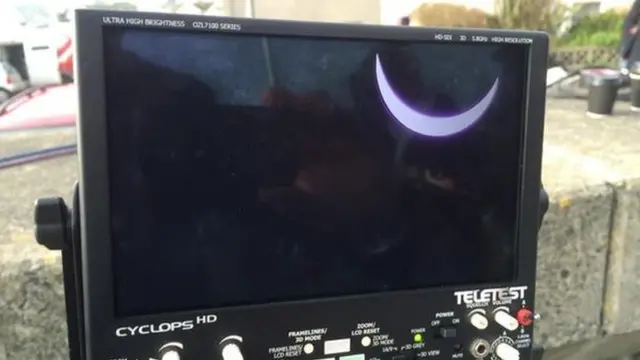
The BBC's John Maguire has tweeted, external another image of that solar grin, as seen through a screen.
BBC presenter Liz Bonnin watched the total eclipse over the Faroe Islands. She said: "I never really thought it was going to be this moving."
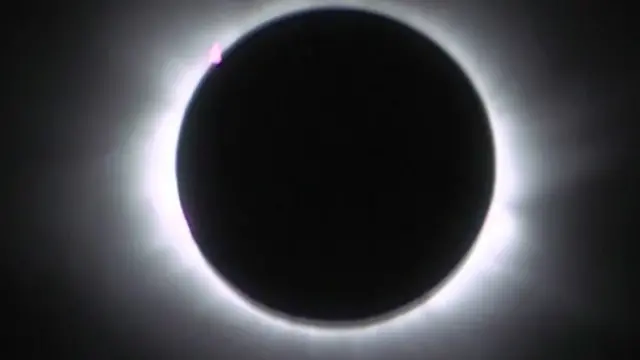
What an amazing image - here's the total eclipse in the Faroe Islands.
Steve Hann, Faversham, Kent emails: I can't understand the panic over the supposed energy crisis the eclipse is going to cause. Isn't the country plunged into darkness every night? I'm sure if we can survive an 11 hour blackout at night, 2 minutes should be a doddle. Wont be any worse than everyone putting their kettles on after Eastenders I would suspect!
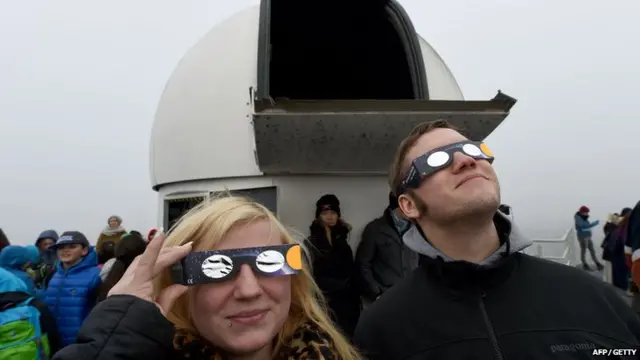 Image source, AFP/Getty
Image source, AFP/GettyIt's cloudy in many parts of the UK and Europe, as you can see here with this picture taken at an observatory in Kiel, northern Germany.
Rob Johnson sent us this picture form Aberystwyth in Wales
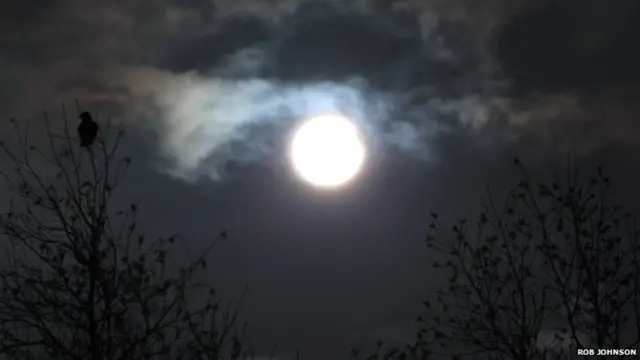 Image source, Rob Johnson
Image source, Rob JohnsonMatthias B in Iceland sent us this picture of his view of the eclipse
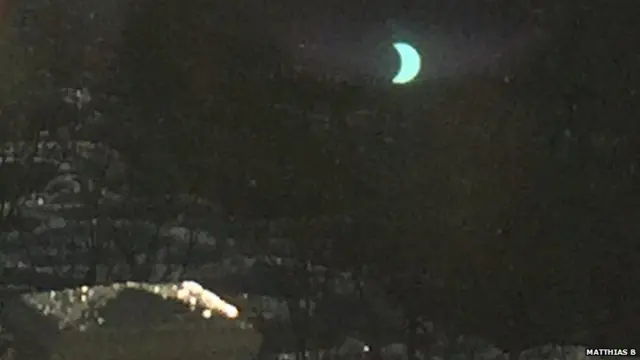 Image source, Matthias B
Image source, Matthias BSee the total eclipse in Faroe Islands by clicking on the "Live Coverage" tab above. Totality will last two minutes and 47 seconds.
Our ability to see eclipses like this is down to pure luck. The Sun is around 400 times bigger than the Moon - but it also happens to be about 400 times further away. This makes them appear roughly the same size when viewed from Earth, so the Moon is able to block out all of the Sun's disc, leaving the Sun's radiant corona shining behind it like a crown.
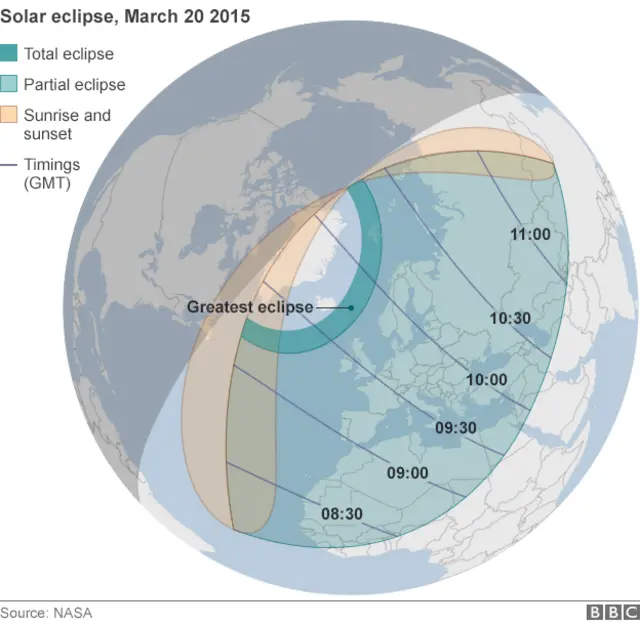
This image shows where in the world the eclipse is visible. Large areas of Europe as well as Asia and Africa can see the phenomenon.
Svalbard, the archipelago north of Norway, saw "first contact" at 09:11 GMT and awaits totality at 10:10 GMT
The Isle of Lewis, off the north coast of Scotland, sees a maximum eclipse. 98% of the Sun is covered by the Moon, creating a sky that resembles twilight.
The eclipse is one of the hot topics on Twitter. The hashtag #Eclipse2015 is trending worldwide, as is Bonnie Tyler - the Welsh singer who sang 1983 power ballad Total Eclipse Of The Heart.
There's a maximum eclipse at Jodrell Bank Observatory in Cheshire. 89% of the Sun is covered by the Moon.
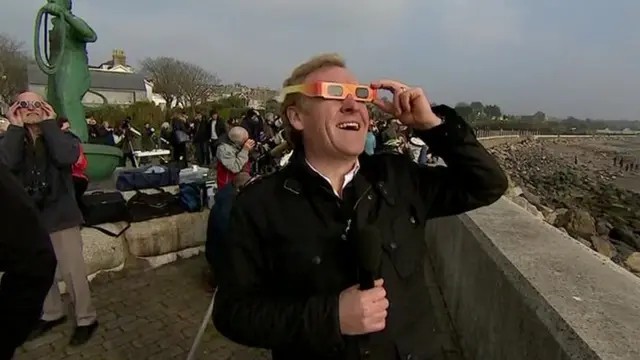
BBC reporter John Maguire says the temperature in Newlyn, Cornwall, has dropped by three degrees or so. He said: "It's quite spooky. It's an eerie feeling."
The Moon doesn't orbit the Earth in a perfect circle, so its distance from us varies. "Supermoons" occur when the Moon makes its closest pass in its orbit around Earth. Moon appears bigger than normal as a result. Last night, our Moon entered this phase, which is why it's close enough to Earth to completely block some light.

If the Moon was further away as it passed in front of the Sun, it would appear smaller and only block out the middle part of the Sun. Anyone standing beneath it would look up and see a 'ring of fire' around the Moon - an "annular" eclipse.
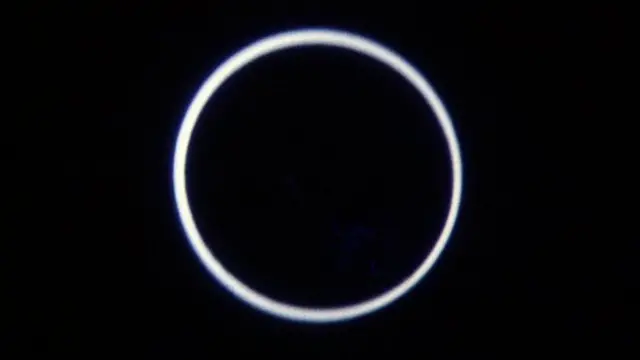 Image source, John McConnell
Image source, John McConnell[Photo by John McConnell, BBC Sky at Night and Stargazing Live Flickr]
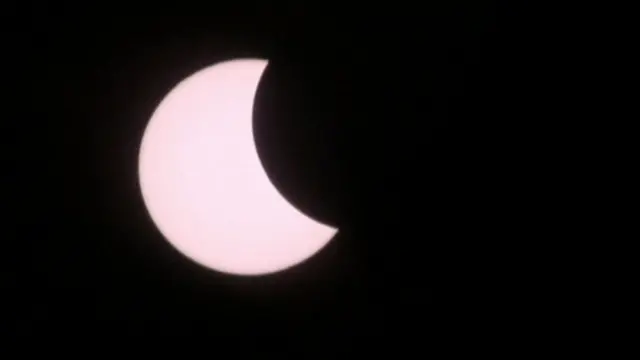 Image source, Reuters
Image source, ReutersHere's how things are looking in Berlin this morning.
The eclipse has reached its maximum over Cornwall. People in the south of the UK see 83% of the Sun's disc covered by the Moon.
The Moon is speeding across the Sun at around 1,400mph (2,253km/h) - that's faster than a Concorde jet.
Watch by clicking the "live coverage" tab above.
As the eclipse races north-west, the Faroe Islands experience 49% eclipse; but at 09:41 GMT they will reach the magical 100% totality.